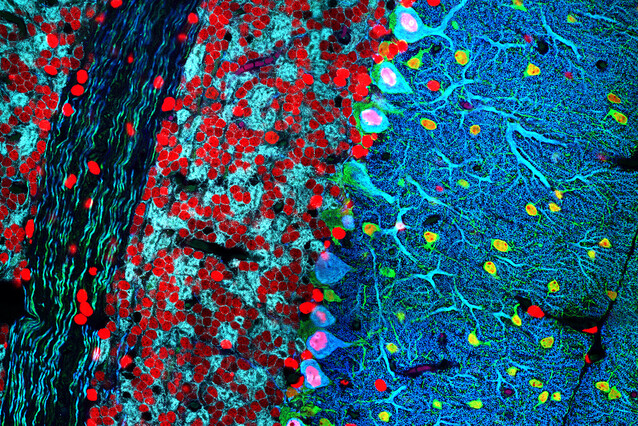Transcription factor PAX5 linked to antibody deficiency and brain development
An international team of scientists has discovered a functional link between the transcription factor PAX5 and both B-cell and brain development in humans. The study, published in the Journal of Experimental Medicine, shows how Pax5 can be the genetic cause of both antibody deficiency and autism spectrum disorder (ASD).
Transcription factors are molecules that switch genes on and off and thereby control the expression of proteins in specific cells over specific periods of time. Pax5 is a transcription factor that the lab of Meinrad Busslinger at the IMP in Vienna has studied extensively, mainly for its role in regulating the development of B-cells and ultimately of acquired immunity in mice. In the early 1990s, Busslinger’s lab also described the effects of Pax5 losses on the anatomy of certain brain regions in mice but did not follow up on the underlying neurobiology at the time. Only recently did the lab turn its attention back to Pax5’s role in brain development – an unlikely twist that was inspired by colleagues in the Netherlands.
Fabian Kaiser is an immunologist and paediatrician at the Erasmus University Medical Center (Erasmus MC) in Rotterdam. He and his colleagues studied the condition of a young man who suffered from recurring infections due to a condition called hypogammaglobulinemia, an inability to produce enough antibodies. The scientists discovered two mutations in the PAX5 gene of the patient. Interestingly, the patient did not only suffer from an immunodeficiency, but also had autism spectrum disorder (ASD), combined with sensorimotor and cognitive deficits. Kaiser reached out to Busslinger for his expertise on Pax5, and to Aleksandra Badura, a neuroscientist at Erasmus MC, to further investigate the neurological aspects. Starting with this autistic patient with an immunodeficiency, an interdisciplinary team formed, searching for a possible single genetic cause of both the antibody deficiency and autism spectrum disorder.
The condition of the Dutch patient is thought to be the result of an inherited PAX5 mutation from his mother, combined with a point mutation of PAX5, which was spontaneously formed and is not present in either parent. The scientists generated a Pax5 mutant mouse model with the exact same mutations to study the underlying role of Pax5 and its connection to the immunological and neurological diagnosis of the Dutch patient.
On the immunological side, Pax5 has been studied in great detail. Among other roles, Pax5 is essential for the formation of B cells, which underly acquired immunity. In the mutant mice, the early development of antibody-producing B-cells was blocked, leading to hypogammaglobulinemia, just as observed in the human case.
In behavioural assessments, the mutant mice showed changes in social interactions, repetitive behaviour, hyperactivity, motor learning, and coordination deficits. Mice are well-established models in autism research, and the observed behavioural traits are known benchmarks for the mouse-equivalent condition.
To explain these behaviours, the scientists took a closer look at the anatomy of the brain. The cerebellum, an essential brain region for motor control and many cognitive functions, was folded differently and did not function as normal. In addition, several midbrain structures were reduced in size due to a strong reduction of a certain type of neuron. These specific neurons are the main source of GABA, a neurotransmitter which inhibits other neurons and therefore prevents them from overfiring. Imbalance between excitation and inhibition of neurons is currently a hotly debated theory for the development of autism, and the Dutch part of the team will follow up on this line of investigation in future studies.
In general, very little is known about the role of PAX5 in brain disorders. PAX5 mutations could recently be identified in some individuals with autism, showing that PAX5 could be a risk gene for ASD. ASD is a heterogeneous condition and often caused by many factors including strong and complex genetic components. The present study describes the first instance of a causal role of a single gene, Pax5, in the generation of both an immunological and neurodevelopmental syndrome.
Original Publication
Fabian M.P. Kaiser, Sarah Gruenbacher, Maria Roa Oyaga, Enzo Nio, Markus Jaritz, Qiong Sun, Wietske van der Zwaag, Emanuel Kreidl, Lydia M. Zopf, Virgil A.S.H. Dalm, Johan Pel, Carolin Gaiser, Rick van der Vliet, Lucas Wahl, André Rietman, Louisa Hill, Ines Leca, Gertjan Driessen, Charlie Laffeber, Alice Brooks, Peter D. Katsikis, Joyce H.G. Lebbink, Kikuë Tachibana, Mirjam van der Burg, Chris I. De Zeeuw, Aleksandra Badura, and Meinrad Busslinger:
“Biallelic PAX5 mutations cause hypogammaglobulinemia, sensorimotor deficits and autism spectrum disorder”. Journal of Experimental Medicine (2022), doi: 10.1084/jem.20220498.
Further reading
